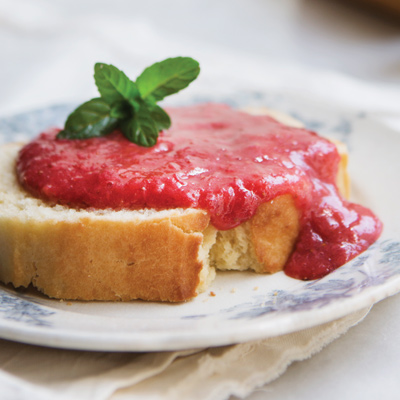Make this vegan pound cake
As a child, I picked strawberries in my mother’s expansive garden. I gathered bowls of sweet, sun-warmed berries that Mom then mashed, smothered with white sugar and poured over a butter-filled pound cake. This was the ’70s after all, when my favorite fruit came from a can of Libby’s Fruit Cocktail.
Now that I’m older and wiser, I appreciate produce that’s not suspended in heavy syrup, and I recently found a cake recipe that uses self-rising flour instead of eggs to lighten its texture. I wondered if I could use the same flour to create a vegan version of my childhood dessert – a cake that was substantial enough to support strawberry sauce and my nostalgia.
Pound cake gets its moniker because it was originally made with a pound each of butter, eggs, flour and sugar. I omitted the butter and eggs in my first test recipe, baking a concoction of self-rising flour, vegetable oil, water, sugar and vanilla. The result was a little flat and a little bland, but not nearly as terrible as I worried a pound cake without butter and eggs would taste.
What happened next can be charitably described as losing my mind. For three days, I tested cake after cake, changing a flour, fat, sugar or liquid each time to see how it affected the taste and texture. It was like I was back in my middle-school science lab, except the results were edible, and I didn’t accidently release a swarm of fruit flies by dropping a test tube.
The self-rising flour, so named for the baking powder and salt already blended into the mix, yielded a cake that was 50 percent taller than one made with all-purpose flour. (The all-purpose flour cake was more akin to a shortbread tea biscuit. Apparently it’s not really for all purposes.) But in the same way bakers use unsalted butter to control sodium in a recipe, I wanted to keep tabs on the baking powder. So instead of self-rising flour, I used low-protein cake flour. Less protein means less gluten is formed in the batter, which makes the cake airier and softer. Between the cake flour and a tablespoon of baking powder, my next test had a lovely, egg-free rise.
A tablespoon of baking powder seems excessive, but I got away with it because I didn’t use any baking soda. Baking soda’s sciency name is sodium bicarbonate. Heat it up and it produces sodium carbonate, aka a weird metallic aftertaste. An acid will partially neutralize the sodium carbonate and its nasty flavor, which is why biscuit recipes that call for baking soda typically also call for acidic buttermilk instead of regular milk. My cake recipe doesn’t have an acid like lemon or vinegar, so baking soda was out. But baking powder, which is baking soda with the right amount of a neutralizing acid already included, worked like a charm.
Once I nailed down the flour and leavening, the rest of the recipe fell together. A cake made with vegetable oil was less gunky than one made with melted margarine, a cake that I fondly dubbed “the teenager” because it was brittle on the outside and gooey on the inside. I learned that coconut milk yogurt did nothing to improve the cake, but almond milk yogurt added a wonderful graham-cracker taste and buttery mouth feel. And though it pains me to say Mom was right, old-school white sugar yielded a finer crumb than those 21st-century, fancy-pants sweeteners agave and turbinado sugar.
While it’s not technically an ingredient, I can’t overstate how helpful it was to measure the flour using a digital scale. A good scale can be had for less than $35, and it’s exponentially more accurate and faster than the spoon-and-level method. The scale helped me make the recipe from start to delicious finish in less than an hour, leaving me plenty of time to contemplate a career in food science – as long as no fruit flies are involved.
Vegan Vanilla Not-pound Cake with Strawberry Sauce
8 servings
Vegan margarine, such as Earth Balance Vegan Buttery Sticks, or cooking spray, for greasing
2¼ cups (10 oz.) cake flour, such as King Arthur Unbleached Cake Flour Blend
¾ cup (6 oz.) sugar, divided
½ cup vegetable oil
½ cup water
6 oz. vanilla almond milk “yogurt,” such as So Delicious Dairy Free
1 Tbsp. baking powder
3 tsp. vanilla extract, divided
1 pint fresh strawberries, stemmed and quartered
1 tsp. lemon juice
Fresh mint leaves, for garnish
• Preheat the oven to 350 degrees. Grease a 9-inch round cake pan with the margarine and set aside.
• In a large mixing bowl, combine the cake flour, ½ cup sugar, vegetable oil, water, yogurt, baking powder and 2 teaspoons vanilla extract. Mix until the batter is smooth.
• Pour the batter into the prepared pan and bake 35 to 40 minutes, until the top is golden brown. Remove from the oven and let cool to room temperature.
• Meanwhile, in a heavy-bottomed pot, heat the strawberries and the remaining ¼ cup sugar over medium-high heat. Cook 5 minutes, stirring frequently, until the strawberries soften and their juices release and thicken.
• Remove the sauce from the heat, stir in the remaining 1 teaspoon vanilla extract and the lemon juice. Using an immersion blender, purée the strawberry sauce. Set aside and let cool to room temperature.
• To serve, drizzle 3 tablespoons strawberry sauce over each cake slice and garnish with the fresh mint.
Tags : Recipes
Related Recipes
Most Recent
Mexican restaurant The Salted Lime now open at Ameristar Casino in St. Charles
Ameristar Casino Resort Spa St. Charles at 1 Ameristar Blvd. has a new …







